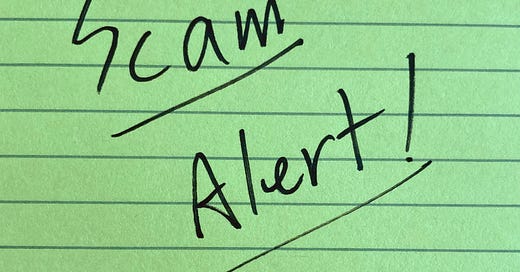I had a phone call with someone who was introduced by a friend. She was very pleasant and enthusiastic. After some small talk, the topic moved to the financial product her firm was working on. Because the firm’s license from the Monetary Authority of Singapore was still pending, they were only accepting non-Singapore residents (1st sign of concern). While I am talking, I am checking the firm’s website. They are headquartered in Europe without any financial license but only an agreement to represent another brokerage firm (2nd concern).
She said that the firm have been very successful in Japan working with a Japanese brokerage firm but she would not disclose the name of the firm for confidentiality reasons (3rd concern). She said that the firm has a team of 6 Japanese dedicated to the Japanese business which she is not part of. The product that is popular in Japan provides a promotional 8% annual return, guaranteed, distributed on a monthly basis using high frequency trading (HFT) in FX.
Because I am interested in different types of investment strategies, I ask, “so, how does your HFT work?” She says part of it is algorithms. Then I ask, “What about the other part?” as all the HFT strategies I encountered have only algorithms (you can’t trade in mili-seconds without a computer with an algorithm), she says the Japan team does the trade (4th concern). I also ask about who guarantees the return and she discloses three reputable banks, two from Europe and one from Japan. And she says that her CEO decides which bank will be used for the guarantee (5th concern, because that should not be a discretionary decision, rather a business decision based on the terms).
By now, I am switching to learning mode, meaning, wondering how she tries to get me hooked.
I thought it would be worth sharing the following:
The investor will first open an offshore account with her firm and wire the money. Later, only when the investor feels ready, they can instruct her firm to invest the money in the fund. This gives a sense of control to the investor.
The investment will be in BVI or Seychelles, but the two jurisdictions are not included in the teaser. Later in the conversation, she discusses Singapore trusts, trying to dazzle me with the different locations. While we are talking she sends me a teaser which does not include any of these wonderful places. However, it does talk about New Zealand trust and Special Purpose Vehicles. New Zealand is a wonderful place, too.
The teaser says “16% Return at Full Term”, “Asset Protection Platform”, “100% Principal Returned”, “Fixed Return 8% p.a. (Promotion rate, paid monthly)”. All nice numbers and claims designed to confuse you.
The teaser also discusses how the protection works. It includes “rigorous due diligence” (that’s a start), “risk management structures” (that doesn’t protect anything), “segregated client portfolio management” (that also doesn’t protect anything), 100% Principal protected MTN Program issued by AA & A rated Banks, Insurance/ Re-Insurance (Re-Insurance is an insurance for insurance companies and they cannot be a direct counterparty to protect an investment)… the list goes on...
The teaser ends with other buzz words like “Highly regarded”, “safeguard”, “Exclusive direct access”, “Alternative & uncorrelated range of assets with excellent diversification benefits agains fluctuation of global markets”, “risk mitigation”, “secure online virtual platform”, and “international privacy and secrecy rules & regulations.”
What is missing in the teaser is also interesting. There is no indication of third party professional organisations. The Custodian, administrator, legal firm, and accounting firm are typically mentioned and investors can verify (more on that later).
We end the conversation with the understanding that her colleague will contact me with further information, which I doubt will come.
There is one thing that I agree with the teaser; rigorous due diligence mitigates operational risk, including scams. It can protect an investor from a fraud (but not from a failed investment strategy, that is another topic for another day).
Greensill and Envy are two recently reported financial frauds on a global scale. They grabbed the headlines because of the amount of money that got poured in. Before these two, a decade ago, we had Madoff.
These three cases involve large financial institutions, according to the articles. Those information were used by the investors to make an informed decision.
But how many of those who invested actually done the “rigorous due diligence”, that is to verify the claims of the counterparty?
Our brains are wired to save time and energy and if a large financial institution is involved it must be legit, we tend to think (and that also works within the large institutions…). And that rule of thumb works most of the time. Until it doesn't.
There are specialised global due diligence providers that does the tedious, time consuming and complicated work of operational due diligence. Castle Hall, a leading specialist from Canada, has a white paper on Wirecard, yet another fraud that happened a few years ago. It is an interesting read.
Because a reputable financial organization is behind an investment does not make it safe. It is also true that because the main service provider is not a household name makes it unsafe. We just need to do a bit more work to verify the claim, sometimes with the help from others. Yes, it takes time and energy, what does not come naturally to us, but worth the effort when large sums of money is involved.




